2015 CHEVROLET CITY EXPRESS transmission
[x] Cancel search: transmissionPage 150 of 297
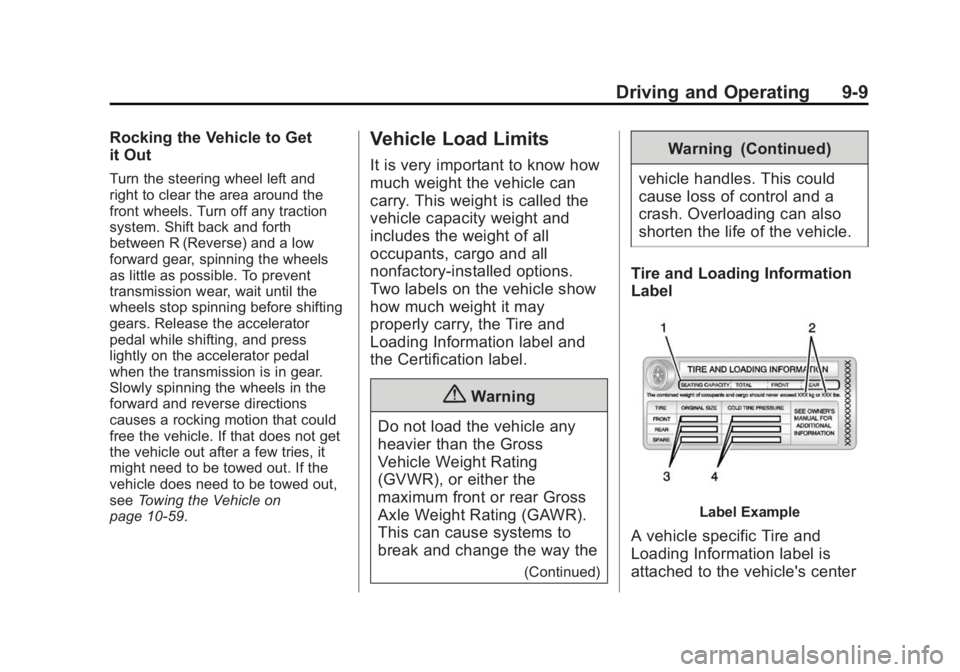
Black plate (9,1)Chevrolet City Express Owner Manual (GMNA-Localizing-U.S./Canada-
7707496) - 2015 - CRC - 11/26/14
Driving and Operating 9-9Rocking the Vehicle to Get
it Out Turn the steering wheel left and
right to clear the area around the
front wheels. Turn off any traction
system. Shift back and forth
between R (Reverse) and a low
forward gear, spinning the wheels
as little as possible. To prevent
transmission wear, wait until the
wheels stop spinning before shifting
gears. Release the accelerator
pedal while shifting, and press
lightly on the accelerator pedal
when the transmission is in gear.
Slowly spinning the wheels in the
forward and reverse directions
causes a rocking motion that could
free the vehicle. If that does not get
the vehicle out after a few tries, it
might need to be towed out. If the
vehicle does need to be towed out,
see Towing the Vehicle on
page 10-59 . Vehicle Load Limits It is very important to know how
much weight the vehicle can
carry. This weight is called the
vehicle capacity weight and
includes the weight of all
occupants, cargo and all
nonfactory-installed options.
Two labels on the vehicle show
how much weight it may
properly carry, the Tire and
Loading Information label and
the Certification label.
{ Warning
Do not load the vehicle any
heavier than the Gross
Vehicle Weight Rating
(GVWR), or either the
maximum front or rear Gross
Axle Weight Rating (GAWR).
This can cause systems to
break and change the way the
(Continued) Warning (Continued)
vehicle handles. This could
cause loss of control and a
crash. Overloading can also
shorten the life of the vehicle.
Tire and Loading Information
Label
Label Example
A vehicle specific Tire and
Loading Information label is
attached to the vehicle's center
Page 156 of 297
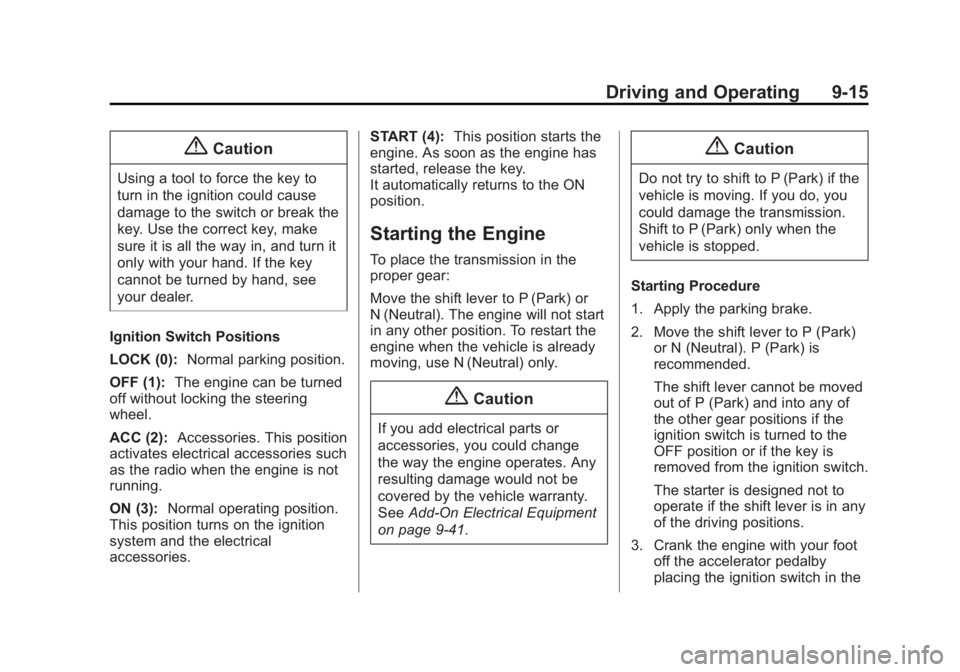
Black plate (15,1)Chevrolet City Express Owner Manual (GMNA-Localizing-U.S./Canada-
7707496) - 2015 - CRC - 11/26/14
Driving and Operating 9-15
{ CautionUsing a tool to force the key to
turn in the ignition could cause
damage to the switch or break the
key. Use the correct key, make
sure it is all the way in, and turn it
only with your hand. If the key
cannot be turned by hand, see
your dealer.
Ignition Switch Positions
LOCK (0): Normal parking position.
OFF (1): The engine can be turned
off without locking the steering
wheel.
ACC (2): Accessories. This position
activates electrical accessories such
as the radio when the engine is not
running.
ON (3): Normal operating position.
This position turns on the ignition
system and the electrical
accessories. START (4): This position starts the
engine. As soon as the engine has
started, release the key.
It automatically returns to the ON
position.
Starting the Engine To place the transmission in the
proper gear:
Move the shift lever to P (Park) or
N (Neutral). The engine will not start
in any other position. To restart the
engine when the vehicle is already
moving, use N (Neutral) only.
{ Caution
If you add electrical parts or
accessories, you could change
the way the engine operates. Any
resulting damage would not be
covered by the vehicle warranty.
See Add-On Electrical Equipment
on page 9-41 .{ CautionDo not try to shift to P (Park) if the
vehicle is moving. If you do, you
could damage the transmission.
Shift to P (Park) only when the
vehicle is stopped.
Starting Procedure
1. Apply the parking brake.
2. Move the shift lever to P (Park)
or N (Neutral). P (Park) is
recommended.
The shift lever cannot be moved
out of P (Park) and into any of
the other gear positions if the
ignition switch is turned to the
OFF position or if the key is
removed from the ignition switch.
The starter is designed not to
operate if the shift lever is in any
of the driving positions.
3. Crank the engine with your foot
off the accelerator pedalby
placing the ignition switch in the
Page 159 of 297
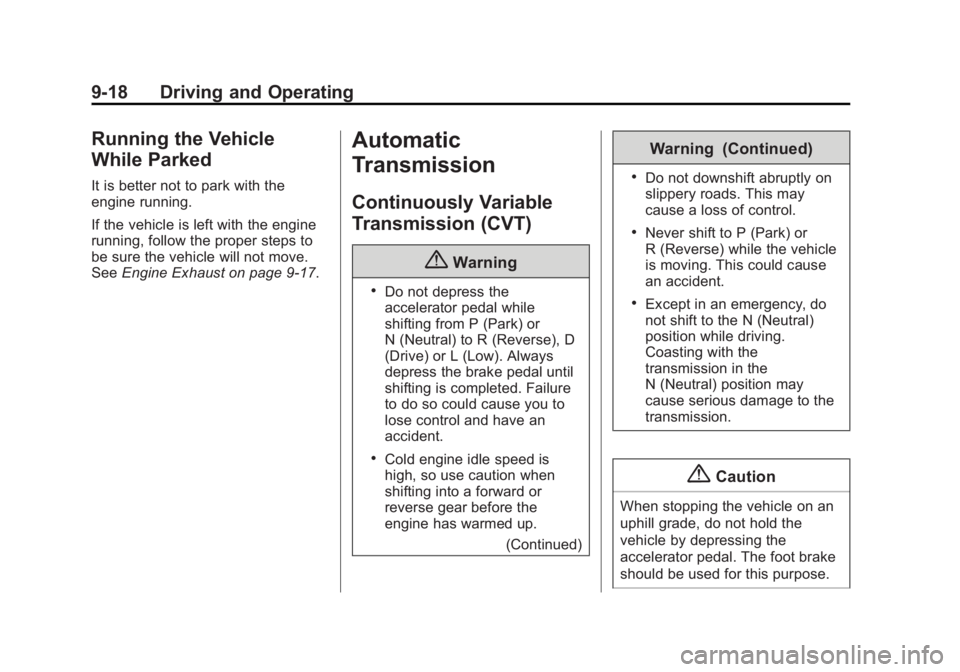
Black plate (18,1)Chevrolet City Express Owner Manual (GMNA-Localizing-U.S./Canada-
7707496) - 2015 - CRC - 11/26/14
9-18 Driving and Operating
Running the Vehicle
While Parked It is better not to park with the
engine running.
If the vehicle is left with the engine
running, follow the proper steps to
be sure the vehicle will not move.
See Engine Exhaust on page 9-17 .
Automatic
Transmission Continuously Variable
Transmission (CVT)
{ Warning .
Do not depress the
accelerator pedal while
shifting from P (Park) or
N (Neutral) to R (Reverse), D
(Drive) or L (Low). Always
depress the brake pedal until
shifting is completed. Failure
to do so could cause you to
lose control and have an
accident. .
Cold engine idle speed is
high, so use caution when
shifting into a forward or
reverse gear before the
engine has warmed up.
(Continued) Warning (Continued) .
Do not downshift abruptly on
slippery roads. This may
cause a loss of control. .
Never shift to P (Park) or
R (Reverse) while the vehicle
is moving. This could cause
an accident. .
Except in an emergency, do
not shift to the N (Neutral)
position while driving.
Coasting with the
transmission in the
N (Neutral) position may
cause serious damage to the
transmission.
{ Caution
When stopping the vehicle on an
uphill grade, do not hold the
vehicle by depressing the
accelerator pedal. The foot brake
should be used for this purpose.
Page 160 of 297
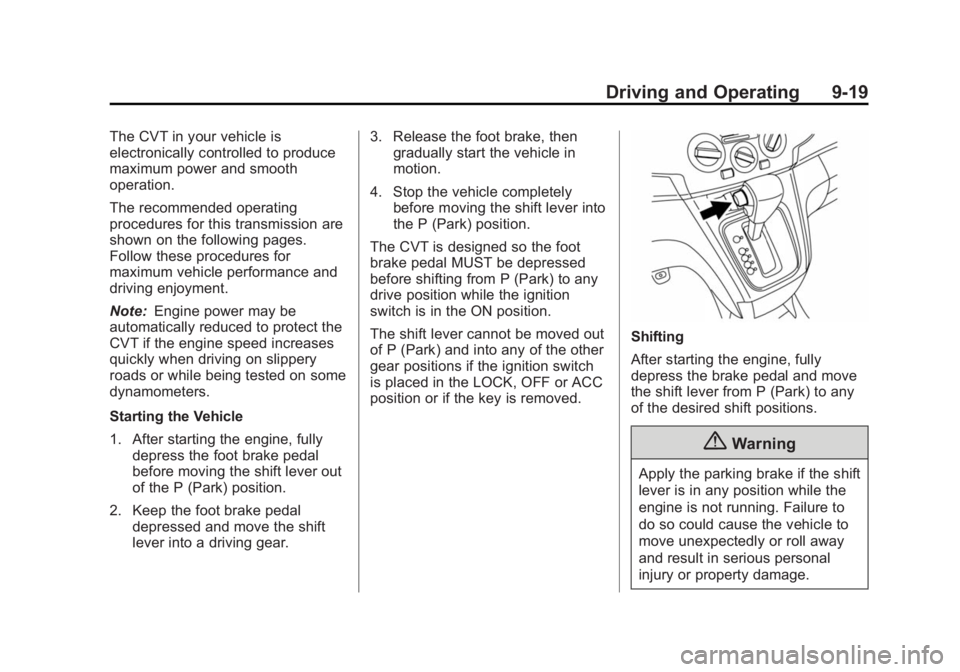
Black plate (19,1)Chevrolet City Express Owner Manual (GMNA-Localizing-U.S./Canada-
7707496) - 2015 - CRC - 11/26/14
Driving and Operating 9-19The CVT in your vehicle is
electronically controlled to produce
maximum power and smooth
operation.
The recommended operating
procedures for this transmission are
shown on the following pages.
Follow these procedures for
maximum vehicle performance and
driving enjoyment.
Note: Engine power may be
automatically reduced to protect the
CVT if the engine speed increases
quickly when driving on slippery
roads or while being tested on some
dynamometers.
Starting the Vehicle
1. After starting the engine, fully
depress the foot brake pedal
before moving the shift lever out
of the P (Park) position.
2. Keep the foot brake pedal
depressed and move the shift
lever into a driving gear. 3. Release the foot brake, then
gradually start the vehicle in
motion.
4. Stop the vehicle completely
before moving the shift lever into
the P (Park) position.
The CVT is designed so the foot
brake pedal MUST be depressed
before shifting from P (Park) to any
drive position while the ignition
switch is in the ON position.
The shift lever cannot be moved out
of P (Park) and into any of the other
gear positions if the ignition switch
is placed in the LOCK, OFF or ACC
position or if the key is removed. Shifting
After starting the engine, fully
depress the brake pedal and move
the shift lever from P (Park) to any
of the desired shift positions.
{ Warning
Apply the parking brake if the shift
lever is in any position while the
engine is not running. Failure to
do so could cause the vehicle to
move unexpectedly or roll away
and result in serious personal
injury or property damage.
Page 161 of 297
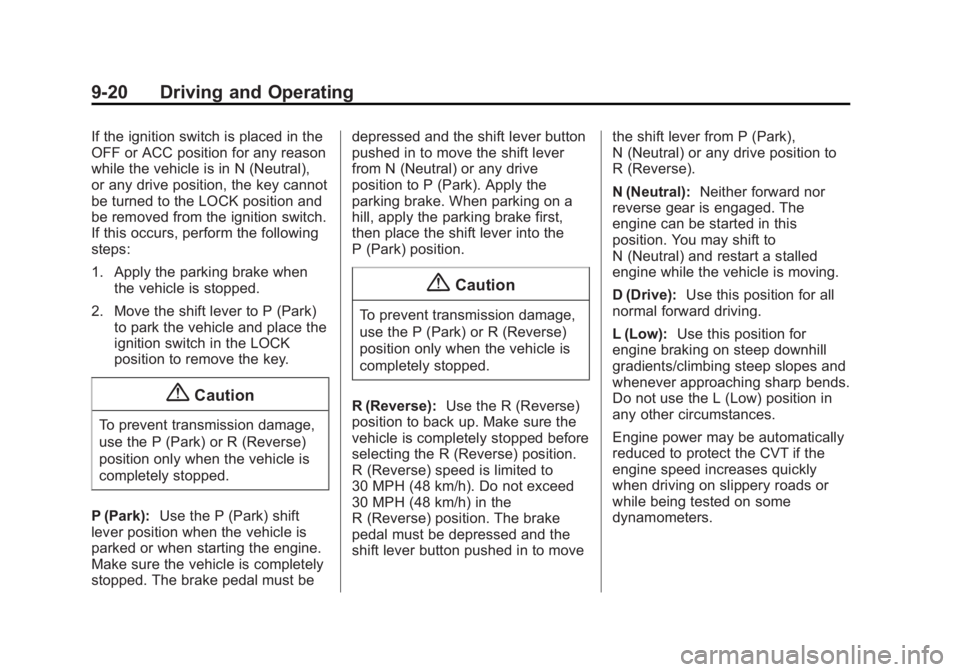
Black plate (20,1)Chevrolet City Express Owner Manual (GMNA-Localizing-U.S./Canada-
7707496) - 2015 - CRC - 11/26/14
9-20 Driving and Operating If the ignition switch is placed in the
OFF or ACC position for any reason
while the vehicle is in N (Neutral),
or any drive position, the key cannot
be turned to the LOCK position and
be removed from the ignition switch.
If this occurs, perform the following
steps:
1. Apply the parking brake when
the vehicle is stopped.
2. Move the shift lever to P (Park)
to park the vehicle and place the
ignition switch in the LOCK
position to remove the key.
{ Caution
To prevent transmission damage,
use the P (Park) or R (Reverse)
position only when the vehicle is
completely stopped.
P (Park): Use the P (Park) shift
lever position when the vehicle is
parked or when starting the engine.
Make sure the vehicle is completely
stopped. The brake pedal must be depressed and the shift lever button
pushed in to move the shift lever
from N (Neutral) or any drive
position to P (Park). Apply the
parking brake. When parking on a
hill, apply the parking brake first,
then place the shift lever into the
P (Park) position.
{ CautionTo prevent transmission damage,
use the P (Park) or R (Reverse)
position only when the vehicle is
completely stopped.
R (Reverse): Use the R (Reverse)
position to back up. Make sure the
vehicle is completely stopped before
selecting the R (Reverse) position.
R (Reverse) speed is limited to
30 MPH (48 km/h). Do not exceed
30 MPH (48 km/h) in the
R (Reverse) position. The brake
pedal must be depressed and the
shift lever button pushed in to move the shift lever from P (Park),
N (Neutral) or any drive position to
R (Reverse).
N (Neutral): Neither forward nor
reverse gear is engaged. The
engine can be started in this
position. You may shift to
N (Neutral) and restart a stalled
engine while the vehicle is moving.
D (Drive): Use this position for all
normal forward driving.
L (Low): Use this position for
engine braking on steep downhill
gradients/climbing steep slopes and
whenever approaching sharp bends.
Do not use the L (Low) position in
any other circumstances.
Engine power may be automatically
reduced to protect the CVT if the
engine speed increases quickly
when driving on slippery roads or
while being tested on some
dynamometers.
Page 163 of 297
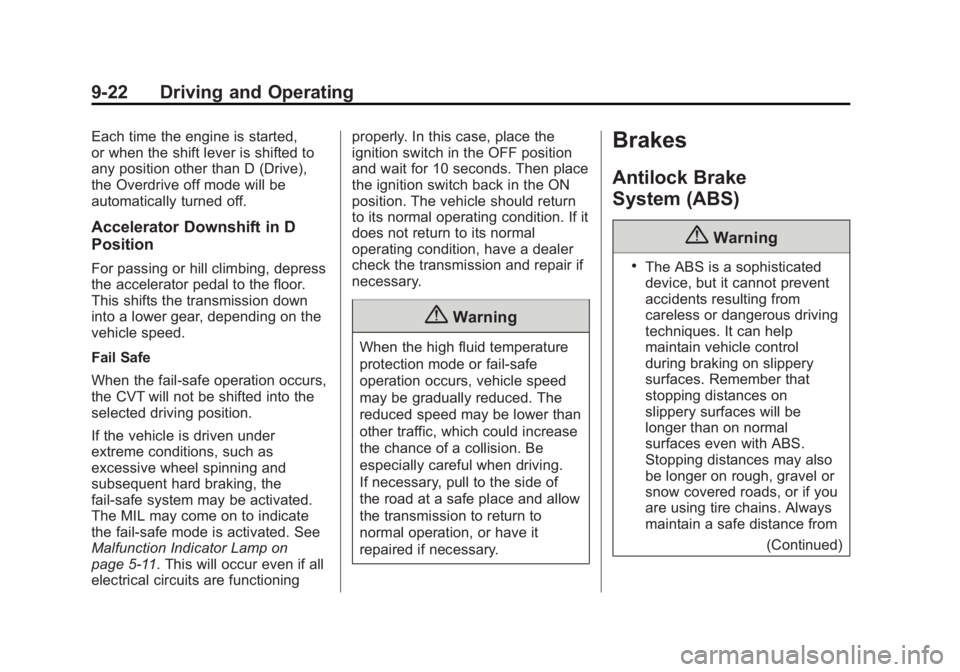
Black plate (22,1)Chevrolet City Express Owner Manual (GMNA-Localizing-U.S./Canada-
7707496) - 2015 - CRC - 11/26/14
9-22 Driving and Operating Each time the engine is started,
or when the shift lever is shifted to
any position other than D (Drive),
the Overdrive off mode will be
automatically turned off.
Accelerator Downshift in D
Position For passing or hill climbing, depress
the accelerator pedal to the floor.
This shifts the transmission down
into a lower gear, depending on the
vehicle speed.
Fail Safe
When the fail-safe operation occurs,
the CVT will not be shifted into the
selected driving position.
If the vehicle is driven under
extreme conditions, such as
excessive wheel spinning and
subsequent hard braking, the
fail-safe system may be activated.
The MIL may come on to indicate
the fail-safe mode is activated. See
Malfunction Indicator Lamp on
page 5-11 . This will occur even if all
electrical circuits are functioning properly. In this case, place the
ignition switch in the OFF position
and wait for 10 seconds. Then place
the ignition switch back in the ON
position. The vehicle should return
to its normal operating condition. If it
does not return to its normal
operating condition, have a dealer
check the transmission and repair if
necessary.
{ WarningWhen the high fluid temperature
protection mode or fail-safe
operation occurs, vehicle speed
may be gradually reduced. The
reduced speed may be lower than
other traffic, which could increase
the chance of a collision. Be
especially careful when driving.
If necessary, pull to the side of
the road at a safe place and allow
the transmission to return to
normal operation, or have it
repaired if necessary. Brakes Antilock Brake
System (ABS)
{ Warning .
The ABS is a sophisticated
device, but it cannot prevent
accidents resulting from
careless or dangerous driving
techniques. It can help
maintain vehicle control
during braking on slippery
surfaces. Remember that
stopping distances on
slippery surfaces will be
longer than on normal
surfaces even with ABS.
Stopping distances may also
be longer on rough, gravel or
snow covered roads, or if you
are using tire chains. Always
maintain a safe distance from
(Continued)
Page 165 of 297
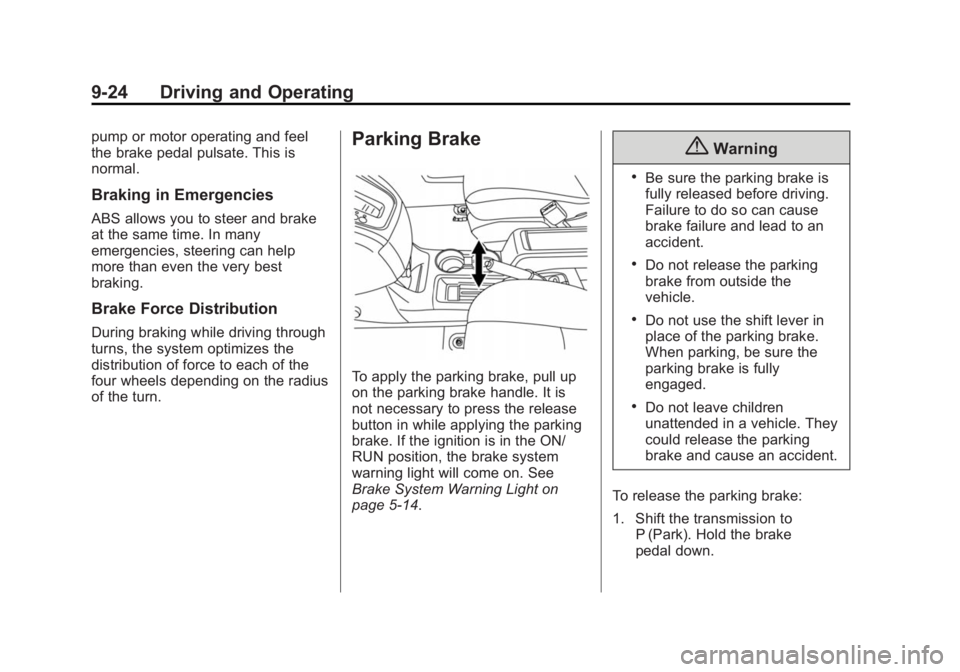
Black plate (24,1)Chevrolet City Express Owner Manual (GMNA-Localizing-U.S./Canada-
7707496) - 2015 - CRC - 11/26/14
9-24 Driving and Operating pump or motor operating and feel
the brake pedal pulsate. This is
normal.
Braking in Emergencies ABS allows you to steer and brake
at the same time. In many
emergencies, steering can help
more than even the very best
braking.
Brake Force Distribution During braking while driving through
turns, the system optimizes the
distribution of force to each of the
four wheels depending on the radius
of the turn. Parking Brake
To apply the parking brake, pull up
on the parking brake handle. It is
not necessary to press the release
button in while applying the parking
brake. If the ignition is in the ON/
RUN position, the brake system
warning light will come on. See
Brake System Warning Light on
page 5-14 .{ Warning .
Be sure the parking brake is
fully released before driving.
Failure to do so can cause
brake failure and lead to an
accident. .
Do not release the parking
brake from outside the
vehicle. .
Do not use the shift lever in
place of the parking brake.
When parking, be sure the
parking brake is fully
engaged. .
Do not leave children
unattended in a vehicle. They
could release the parking
brake and cause an accident.
To release the parking brake:
1. Shift the transmission to
P (Park). Hold the brake
pedal down.
Page 171 of 297

Black plate (30,1)Chevrolet City Express Owner Manual (GMNA-Localizing-U.S./Canada-
7707496) - 2015 - CRC - 11/26/14
9-30 Driving and Operating Ending Cruise Control
There are four ways to end cruise
control: .
Step lightly on the brake pedal. .
Press CANCEL. .
Shift the transmission to
N (Neutral). .
To turn off cruise control, press
CRUISE ON/OFF.
Erasing Speed Memory
The cruise control set speed is
erased from memory if CRUISE ON/
OFF is pressed or if the vehicle is
turned off. Driver Assistance
Systems Parking Assist
{ Warning .
Always turn and look back
before backing up. The RPA
is not a substitute for proper
backing procedures.
(Continued) Warning (Continued) .
Read and understand the
limitations of the rear parking
assist system as contained in
this section. Inclement
weather may affect the
function of the RPA; this may
include reduced performance
or a false activation. .
This system is not designed
to prevent contact with small
or moving objects. .
The system is designed as a
aid to the driver in detecting
large stationary objects to
help avoid damaging the
vehicle. The system will not
detect small objects below
the bumper, and may not
detect objects close to the
bumper or on the ground. .
If your vehicle sustains
damage to the rear bumper
fascia, leaving it misaligned
(Continued)